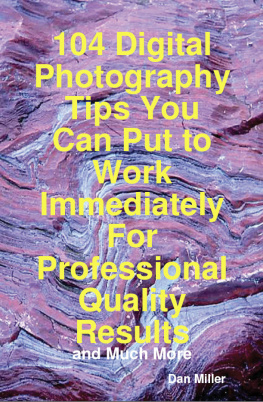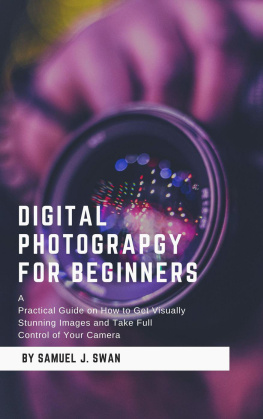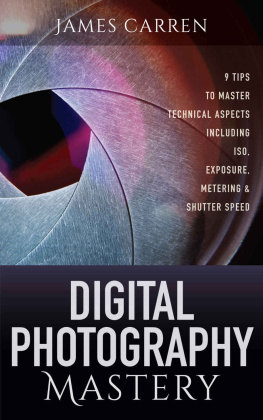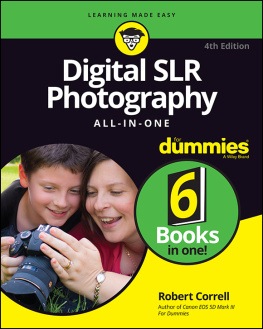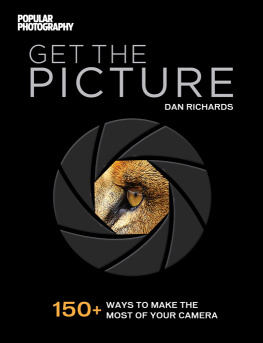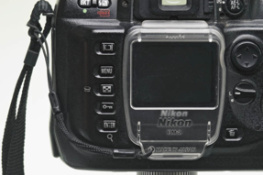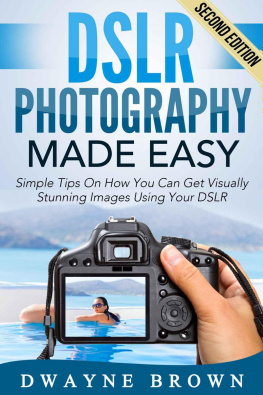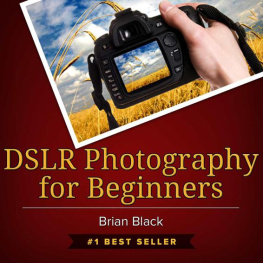DSLR Photography for Beginners: Master Your DSLR Camera & Improve Your Digital SLR Photography Skills and Knowledge.

By Shawn Cannon
(Illustrated Edition)Pictures provided by Kim B.
Copyright @ 2010 by SWB BOOK S 
FIRST PUBLICATION EDITION SWB PUBLISHERS
10 9 8 7 6 5 4 3 2 1
This book contains material protected under International and Federal Copyright Laws and Treaties. Any unauthorized reprint or use of this material is prohibited. No part of this book may be reproduced or transmitted in any form or means, electronic, or mechanical, including photocopying, recording, or by any information storage without express written permission from the publisher.
Summary
In this book, you will understand the origins of the Camera and how photography rose to fame and became one great profession that is not necessarily for everyone. This book will help you understand why a DSLR camera is the best pick for either the beginner, intermediate, or the advanced photographer.
Go back in time and revisit how the camera came to life. Meet the earliest ones ever developed and the impact it had to the whole world, shaping the culture and outlook that we now have towards photography and the art of taking great images. Know the various advantages and disadvantages of the DSLR as it is compared to other digital compact cameras which is its primary competition right now.
You will come to know the different parts of the DSLR and its many functions and features that greatly affects the outcome of your pictures and images. Find out how you can take better and greater pictures of any subject by checking out how you can tweak the modes in your DSLR and, of course, learn a thing or two from the tips and pointers in achieving engaging and captivating photographs.
Contents
Introduction
Are you fond of taking pictures and have a love for editing and making your shots even more amazing? Or are you still an amateur photo addict who is looking for better ways to take beautiful pictures? If youre a photo geek and would like to develop and hone your skills in photography and the art of getting that perfect, captivating shot.
Even if you have a great eye for beauty and art, its the tools that you use that will propel your talent even further. So this just means that you should be equipped with the right materials and instruments in doing your craft. As simple as it may seem to others, professional photography is a complex undertaking and to become successful at it, you need top-notch tools or instruments. One great instrument is the camera. Having the right camera to capture the beautiful images you see with your eyes will surely make the task a lot easier and more creative.
What should you look for in a camera? What are the specific lens types, size, and other specifications must you keep in mind when choosing the right instrument? Lets get to the basics and expand from there so you can have an idea of what a great camera is.
Chapter 1: History of the Camera

Organically speaking, a camera is an optical device capable of recording pictures or images which can be stored in itself or transported to another device or location. The origin of the word camera came from the word camera obscura which literally means dark chamber and it was also the original name of the device that projected images onto a flat surfaced medium.
In todays photography, your camera is one of your most important tools, it is your most crucial instrument. More than just a box that can store your images, it is a device that controls the amount of light that is transported into a piece of film that is light sensitive or whatever surface it has inside.
Its interesting to know that the first cameras didnt even have any glass lenses in them. The first cameras were just simple devices that had a tiny hole in front of the box which allowed the entrance of light and also to enable the photographer to focus on the image he is trying to capture. With the steady rise and domination of science and technology, that simple box called a camera evolved and many variations and styles emerged as the whole world moved forward into the more modern society that we have now. Many companies took on the challenge of developing the camera and as a result, more and more people got interested in them as photography became a profession and a popular hobby for many. These companies are still continuously coming out with newer and more tech savvy versions and one example of one such advanced device is the DSLR camera.
Types of Cameras
Before we delve and become more familiar with the DSLR camera, lets try to look at the different types of cameras as it made its way into the 21 st century, way before photography became an art form.
- Camera Obscura
Origin:
This was the first recorded camera that existed which possibly dates back to the ancient Greeks and ancient Chinese people. In 1021 AD, the creation of the first pinhole camera was published by Ibn al-Haytham after he observed that the light that travelled through a window shutter had an effect of mirroring the image seen and the smaller the hole of the box, the sharper the images were.
Function:
These early versions of the camera were actually the size of a small room where two people can fit in. The reason for this space is for the person to manually trace the image they are seeing but this soon became impractical so people have developed smaller and more compact versions of it as the centuries progressed.
- Early Fixed Images
Origin:
Nicephore Niepce invented his own portable camera in 1816 and the first photograph made by a camera was then released using this camera. It was a partial success because the materials used by Niepce were not permanent making the image unrecognizable after being exposed to light.
Function:
Niepce used a portable camera to capture the image but the camera had paper in it which was coated with silver chloride. This chemical darkens when it is exposed to light so when the image was captured, the silver chloride reacted with the paper, darkening it in the portions where there was an image but the surrounding areas eventually darkened altogether after being exposed to light after some time.
- Daguerreotypes and Calotypes
Origin:
Louis Daguerre, Niepces partner, continued developing Niepces work after he died in 1833 and after 4 years, Daguerre finally developed the first process of practical photography, the Daguerreotype, but only released it publicly in 1839. The calotype was later on perfected by Henry Fox Talbot in 1840 which was a different version of the process.
Function:
Daguerre developed a process where the paper used inside the camera device was coated with silver iodide which was light-sensitive making it possible for the image to be developed by mercury vapor and a strong mixture of sodium chloride or salt. The calotype also used two nested boxes as the camera, same as the one used by Daguerre, but Talbots version had a few more steps to it.
- Dry plates
Origin:
The emergence of dry plates started in 1855 by Desire van Monckhoven which was then later on improved and developed by other inventors until 1878 where the most advanced dry plate camera came to life.
Function:


